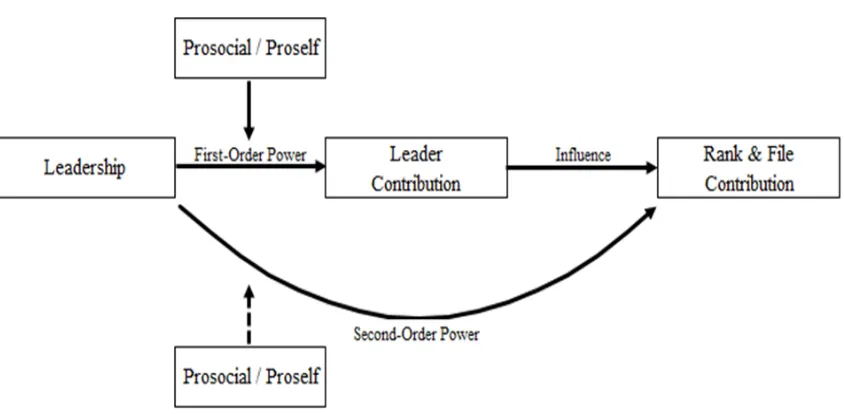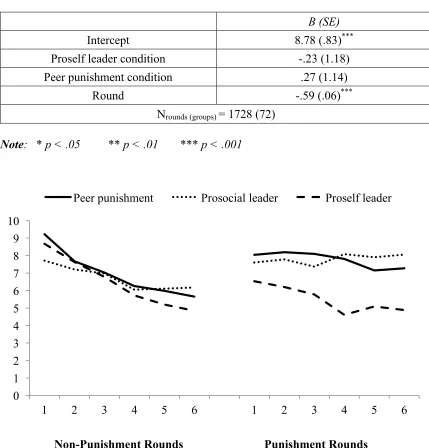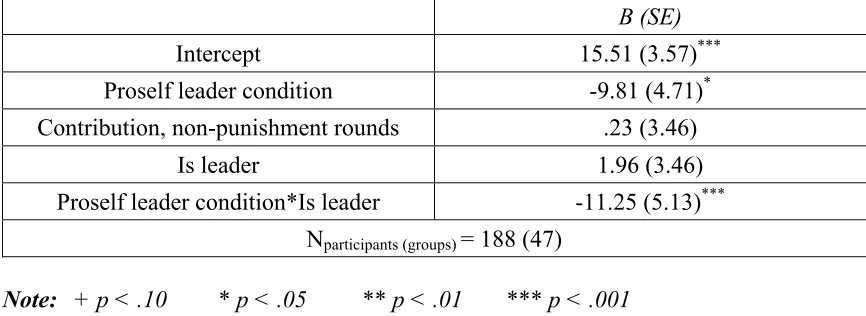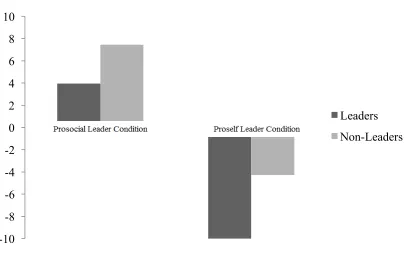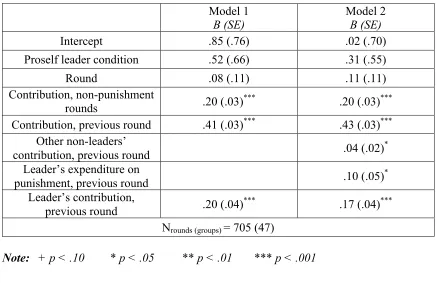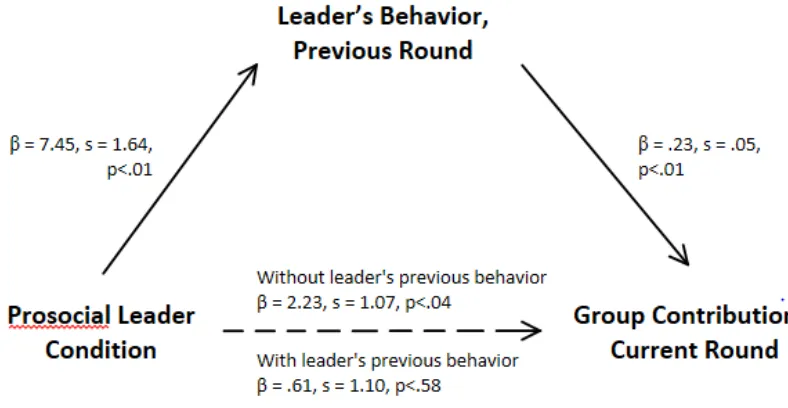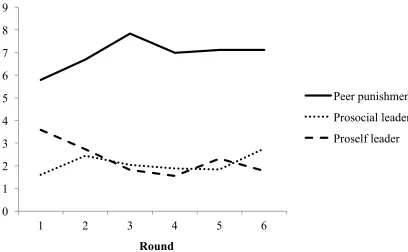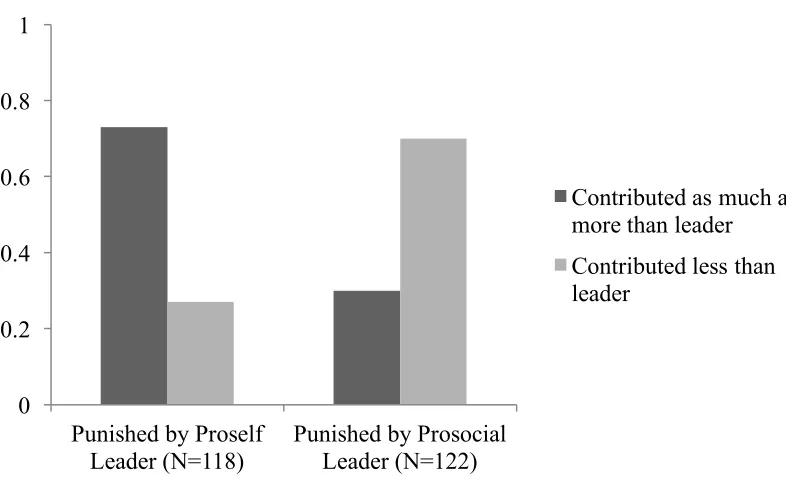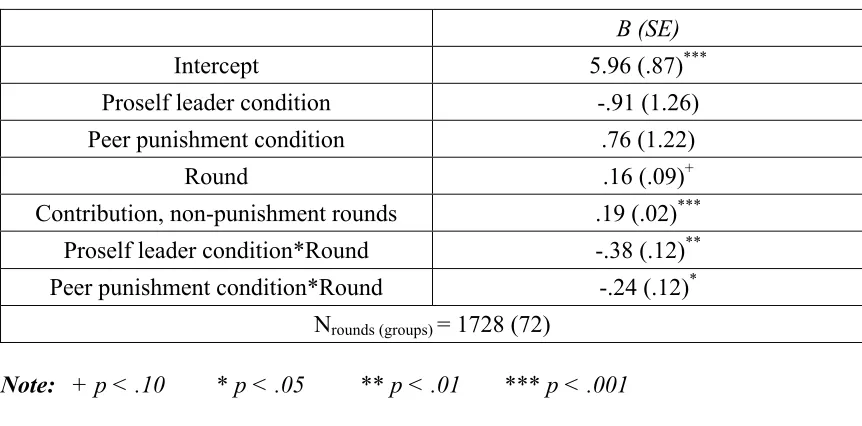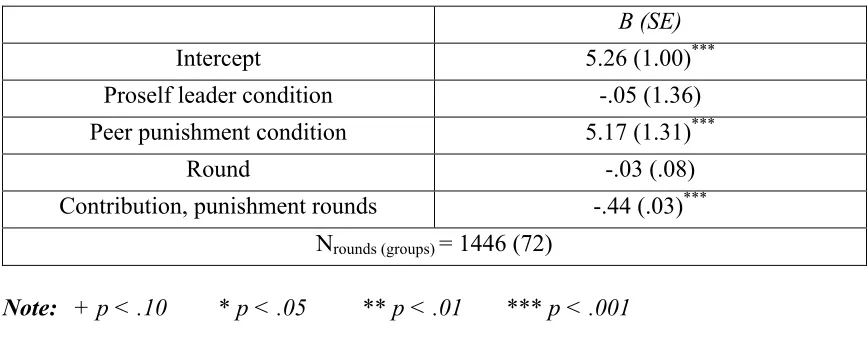University of South Carolina
Scholar Commons
Theses and Dissertations
2017
The Dynamics of Prosocial Leadership: Power and
Influence in Collective Action Groups
Ashley Harrell
University of South Carolina
Follow this and additional works at:https://scholarcommons.sc.edu/etd
Part of theSociology Commons
This Open Access Dissertation is brought to you by Scholar Commons. It has been accepted for inclusion in Theses and Dissertations by an authorized administrator of Scholar Commons. For more information, please contactdillarda@mailbox.sc.edu.
Recommended Citation
THE DYNAMICS OF PROSOCIAL LEADERSHIP: POWER AND INFLUENCE IN
COLLECTIVE ACTION GROUPS
by
Ashley Harrell
Bachelor of Arts
University of South Carolina, 2008
Master of Arts
University of South Carolina, 2010
Submitted in Partial Fulfillment of the Requirements
For the Degree of Doctor of Philosophy in
Sociology
College of Arts and Sciences
University of South Carolina
2017
Accepted by:
Brent Simpson, Major Professor
Barry Markovsky, Committee Member
Shane Thye, Committee Member
Robb Willer, Committee Member
DEDICATION
To Dad, who since childhood has taught me all the important things in life: that
bearings make things go ‘round, that one should always (loudly) test out the sound
system in the car before buying it, and, just as importantly: to figure out what I want, and
ACKNOWLEDGEMENTS
I am very grateful for the financial support I received in order to complete my
dissertation. Specifically, the work was supported by a SPARC Graduate Research Grant
from the Office of the Vice President for Research at the University of South Carolina, a
Bilinski Educational Foundation Fellowship, and grant SES-1058236 from the National
Science Foundation.
I have received many helpful comments and much support over the course of this
project from my committee members: Barry Markovsky, Shane Thye, and Robb Willer.
Many of my graduate student colleagues provided comments, insights, and friendship. I
also appreciate my family and friends who asked questions—but not too many
questions—about how my work was going, and provided advice, help, and sanity checks
when needed. Extra special thanks and love to my husband Josh, who supported me in so
many ways as I completed this project and my degree.
Last but certainly not least, I am particularly grateful to my committee chair,
Brent Simpson. Over the years I have known him, Brent has given me countless hours of
ABSTRACT
This project bridges insights from theories of collective action, power, and
influence to address the conditions under which group leaders solve collective action
problems. Specifically, I show how group leaders’ behaviors impact the success of
collective action groups as a whole via both power and influence processes. The results
of a laboratory experiment support the prediction that other-regarding (prosocial) leaders
increase their contributions to the group after ascending to leadership, while
self-regarding (proself) leaders reduce their contributions. Further, I show that rank and file
group members are influenced by their leaders’ contribution behaviors; as a result,
prosocial-led groups as a whole are substantially more productive than proself-led
groups. Indeed, as predicted, prosocial leaders were even more effective in maintaining
large group contributions than the standard peer sanctioning system, where the ability to
punish others is distributed equally among all group members. Importantly, these results
suggest that prosocial leaders—but not proself leaders—are an effective solution to
collective action problems. Therefore, I also address whether group members tend to
select prosocials for leadership positions (Study 2a), and whether they are able to identify
prosocials when all group members are able to compete for the leadership position by
vying to be elected to the role (Study 2b). Results from these studies suggest that people
prefer prosocials for the leader position, and that while group members do compete for
prosocials remain higher contributors than their proself counterparts. As a result,
prosocials are particularly likely to be selected for leadership positions when group
contributions are known. Study 2b also demonstrates that groups that hold democratic
elections for leadership may induce more cooperative behavior in their members not only
once the leader is installed, but even before leadership hierarchies emerge as a result of
competition to be elected. Taken as a whole, the findings suggest that putting power and
influence in the right hands solves collective action problems and promotes collective
welfare. Leadership—specifically, democratically elected, prosocial leadership—
TABLE OF CONTENTS
DEDICATION ... iii
ACKNOWLEDGEMENTS ... iv
ABSTRACT ...v
LIST OF TABLES ... viii
LIST OF FIGURES ... ix
CHAPTER 1:INTRODUCTION ...1
CHAPTER 2:BACKGROUND ...6
CHAPTER 3:THEORY ...25
CHAPTER 4:STUDY 1 ...33
CHAPTER 5:LEADER ELECTION VS.APPOINTMENT ...59
CHAPTER 6:STUDIES 2A AND 2B ...69
CHAPTER 7:CONCLUSION ...91
REFERENCES ...98
APPENDIX A–SVOMEASURE,STUDY 1 AND STUDY 2B ...111
APPENDIX B–INSTRUCTIONS,STUDY 1 ...114
APPENDIX C–INSTRUCTIONS,STUDY 2A ...122
LIST OF TABLES
Table 4.1 Contributions to the Public Good, Non-Punishment Rounds ...41
Table 4.2 Change in Total Contributions, Non-Punishment Rounds to Punishment Rounds ...44
Table 4.3 Leaders’ Previous Contribution Decision Predicts Non-Leaders’ Current Contribution Decision ...47
Table 4.4 Contributions to the Public Good, Punishment Rounds ...52
Table 4.5 Earnings Deductions Received, Punishment Rounds ...54
Table 4.6 Earnings, Punishment Rounds ...56
Table 6.1 Contributions to the Public Good, Non-Punishment Rounds ...81
LIST OF FIGURES
Figure 2.1 Causal Diagram: How Leaders Impact the Rank and File via Power and
Influence Processes ...29
Figure 4.1 Group-Level Contributions in Non-Punishment and Punishment Rounds, by Condition ...41
Figure 4.2 Change in Total Contributions, Non-Punishment and Punishment Rounds, by Condition and Leader Status ...45
Figure 4.3 Mediation Analyses: Leaders’ Previous Behavior Mediates the Relationship between Condition and Group Contributions ...48
Figure 4.4 Average Earnings Deductions Received, by Round and Condition ...49
Figure 4.5 Punished Group Members’ Contributions vs. Leader’s Contributions ...51
Figure 4.6 Average Earnings after Punishment, by Round and Condition ...55
CHAPTER 1
INTRODUCTION
How people resolve their individual interests with those of the groups they belong
to is a critical question in the social sciences (Cook, Hardin, and Levi 2005; Hardin 1982;
Horne 2009; Olson 1965). In a collective action problem, what is best for the individual
is in conflict with what is best for the group, yet if all pursue their own self-interest, the
group as a whole is worse off (Heckathorn 1996; Marwell and Oliver 1993; Willer 2009).
As Kollock (1998) notes, collective action problems are a ubiquitous part of social life,
ranging from everyday problems such as productivity in work groups to global efforts to
combat climate change. Since Marwell and Ames (1979, 1980), social scientists have
studied contributions to non-excludable public goods as the quintessential collective
action problem, given that self-interested individuals would prefer to free-ride on public
goods produced by others rather than bearing the costs of contributing themselves (Olson
1965).
Perhaps the most widely considered solution to enhance contributions to public
goods has been the introduction of sanctions. Allowing for the punishment or reward of
group members reduces the tension between individual and group goals by making
free-riding, or not contributing, less attractive (Fehr and Gintis 2007; Heckathorn 1989; Macy
1993; Yamagishi 1992). Much past work has shown that people are willing to expend
1992; Yamagishi 1986). Real-world groups often use sanctions to enhance contributions
to public goods (Horne 2009; Strimling and Eriksson 2014).
The prevailing model of sanctions in the experimental literature on collective
action is diffuse or “peer-to-peer” sanctions, where each group member can expend his or
her own resources to deduct earnings from each other group member (Nosenzo and
Sefton 2014; Shinada and Yamagishi 2007). While diffuse punishment systems increase
contributions to collective efforts, researchers have pointed to several critical
disadvantages of using them, as described in the next chapter. Just as importantly,
modelling sanctions in the lab as peer-to-peer treats groups facing public good dilemmas
as non-hierarchical—that is, it ignores the role that social differentiation processes play
in administering punishment and solving collective action problems in real-world groups
(Grossman and Baldassarri 2012).
Perhaps for these reasons, several researchers have begun to address how
designating a single group leader to administer costly sanctions can impact contributions
to collective action groups (Baldassarri and Grossman 2011; Grossman and Baldassarri
2012; Kosfeld and Rustagi 2015; Van Vugt and De Cremer 1999). However, in each of
these studies, the leader was either completely external to the group or, once the leader
had been selected from among the group members, they no longer made contributions
and thus had no vested interest in the collective good. Therefore, no prior studies have
addressed whether and how group leaders’ own contribution behaviors change after
receiving the leader position. Nor have they shown whether and how leaders’
contributions influence the contributions of rank and file members and group-level
capacity to sanction is given to a single group member fare relative to the standard
solution in the literature, where sanctioning capacity is equally distributed among all
group members.
Here I integrate insights from the literatures on collective action, power, and
influence to address how and when leadership can help solve collective action problems.
In the next chapters, after describing my conceptualization of leadership, I argue that
prosocial, or other-regarding, group leaders will lead for the benefit of their groups,
whereas proself (self-regarding)-led groups, on the whole, will be worse off. Perhaps
more importantly, I address why prosocial leaders are so effective. I develop a theory in
Chapter 3 that demonstrates how, via the exercise of power and influence, prosocial (but
not proself) leaders establish norms of high cooperation among members of the rank and
file. In addition, I argue that the benefits of prosocial leadership will exceed those
provided by the standard solution to collective action problems, where the ability to
punish is distributed equally among group members.
I test my hypotheses in a laboratory study. In Study 1, participants face a standard
public good dilemma without sanctions. Then, in the punishment phase of the study, I
manipulate whether one person (the leader conditions) or all group members (the peer
punishment condition) may punish each other group member. I compare two different
leader conditions: one where a prosocial has the sole ability to punish, and one where a
proself is given punishment ability. Results suggest that prosocial leaders increase their
contributions to the group—above and beyond their baseline tendencies to contribute—
after ascending to leadership. Proself leaders, on the other hand, significantly decrease
influence process, leaders’ contribution decisions predict rank and file group members’
future contribution decisions. The result is that prosocial-led groups on the whole
produce larger public goods than either proself-led groups or groups where all members
have the ability to punish. A different pattern emerges for earnings from the public good,
however. Although proself leaders and their rank and file counterparts contribute less to
public goods than peer-punishment groups, both prosocial- and proself-led groups earn
more from the public good than their peer-punishment counterparts, due to the lower use
of wealth-destroying punishments in leader groups. The experimental design, procedures,
and results of Study 1 are detailed in Chapter 4.
The substantial improvement in welfare of groups with prosocial leaders in
particular, relative to those with peer-to-peer sanctioning systems, may explain the
tendency for real-world groups to limit sanctioning capacity to designated leaders or
monitors (Baldassarri and Grossman 2011; Eriksson and Strimling 2012; Ostrom 2000).
However, the results of Study 1 suggest that the benefits of leadership can only accrue to
groups if prosocial individuals ascend to leadership positions, by whatever mechanism.
Thus, one important question that is not addressed in Study 1 is whether prosocials
actually do tend to end up as leaders of collective action groups. Do groups tend to select
their more prosocial members to lead them? I also argue that the election of leaders,
rather than leader appointment, will enhance public good production above and beyond
the ability of elected-leader groups to choose more effective leaders. I discuss these
issues and the motivation for Studies 2a and 2b in Chapter 5.
In a vignette study (Study 2a) I demonstrate that prosocials are preferred for
facing collective action problems would prefer to elect a prosocial. In an experiment
(Study 2b) I show that allowing group members to select their leaders via an election
(compared to, in Study 1, appointment to leadership) enhances public good production in
two ways. First, supporting some past work, groups (both leaders and rank and file group
members) contribute more when the leader was elected rather than appointed. Second,
election to leadership promotes public good production because group members compete
for the leadership position, by contributing more before the election than they do before a
leader will be appointed. Importantly, although allowing groups to elect their leaders
induces competition for leadership, because both prosocials and proselfs cooperate more
when competition for leadership is possible, groups are still able to identify prosocials
and select them for leadership positions. The experimental design, procedures, and results
of Studies 2a and 2b are detailed in Chapter 6.
Taken as a whole, the studies presented here suggest that putting power in the
right hands leads to substantially greater collective welfare than does the current
prevailing solution to collective action problems. In the final chapter I summarize the
findings, and discuss the implications of the results. Finally, I suggest new directions for
CHAPTER 2
BACKGROUND
In order to provide their members with benefits, groups must overcome collective
action problems (Olson 1965). In a collective action problem, individual rationality is in
conflict with collective rationality, such that people may engage in self-interested actions
that do not further the benefits of the group (Heckathorn 1996; Marwell and Oliver 1993;
Willer 2009). How people resolve their individual interests with those of the groups they
belong to is a critical question in the social sciences (Cook, Hardin, and Levi 2005;
Hardin 1982; Horne 2009; Olson 1965). This is particularly true given the ubiquity of
collective action problems: from everyday interpersonal exchanges like productivity in
work groups to the mobilization of large-scale social movements or efforts to combat
climate change, situations often occur where what is best for the individual is at odds
with what is best for the group.
Since Marwell and Ames (1979, 1980), social scientists have studied
contributions to non-excludable public goods as the quintessential collective action
problem, given that self-interested individuals would prefer to free-ride on the public
goods produced by others than to bear the costs of contributing themselves (Olson 1965).
In a public good dilemma, individual group members must decide whether or not to
contribute their private resources to produce a public good that benefits everyone,
regardless of how much each individual contributed—that is, public goods are
regardless of whether, or how much, they have contributed to the provision of the good.
Given that public goods are non-excludable, it is best for any one individual to “free ride”
off of the contributions of others, by enjoying the benefits of the public good without
contributing to its contribution or maintenance (Kollock 1998). But if everyone in the
group does so, then all will be worse off, as the public good will not be provided. Many
important problems facing groups and societies involve the production of public goods:
as briefly noted above, the maintenance of public radio and television, efforts to maintain
clean air and water supplies, blood donation, and a variety of other critical issues involve
the production of a public good.
Given that public goods problems—and collective action problems more
generally—are pervasive in daily life, much past work has considered how they can be
solved. Contrary to a pure rational self-interest perspective, people do make cooperative
choices in collective action situations (Kollock 1998). How do groups motivate their
members to forgo self-interest and contribute to group efforts? Past work has proposed a
variety of explanations for how to increase cooperative behavior in collective action
situations (for reviews, see Kollock 1998; Messick and Brewer 1983). For example,
allowing group members to communicate with each other (Balliet 2010; Dawes,
McTavish, and Shaklee 1977; Ostrom et al. 1992; van de Kragt, Orbell; and Dawes 1983)
and make pledges to cooperate (Chen and Komorita 1994; Kerr et al. 1997; Orbell, van
de Kragt, and Dawes 1988) have been shown to increase cooperation. In addition,
enhanced feelings of social identification with the group can play an important role in
determining whether people will engage in more group-serving behaviors (De Cremer
But perhaps the most widely considered solution to collective action problems has
been the introduction of sanctions, such that group members have the ability to punish
free-riders, reward cooperators, or both (Yamagishi 1986, 1988a; Kollock 1998;
Komorita 1987). Olson (1965) considered “selective incentives”, or private rewards and
punishments to encourage contributions to collective efforts, as a necessity for groups to
solve collective action problems. Since Olson, a host of past research has considered
whether rewards or punishments can successfully induce individuals to put aside their
self-interest and cooperate to solve large-scale collective action problems. Allowing for
the punishment or reward of group members reduces the tension between individual and
group goals by making free-riding, or not contributing, less attractive (Fehr and Gintis
2007; Heckathorn 1989; Macy 1993; Yamagishi 1992).
Of course, sanctions will only impact cooperation if they will actually be
administered—or at least, if there exists a credible threat that they will be administered
(Fehr and Gachter 2000; 2002; Fehr et al. 2002). Importantly, much past work has shown
that people are indeed willing to expend valuable resources to punish free riders, and this
effectively increases contributions to public goods (Fehr and Gachter 2002; Fehr and
Fischbacher 2004; Henrich et al. 2006; Ostrom 1990; Ostrom et al. 1992; Yamagishi
1986, 1988).
In particular, sanctions enhance cooperation via two separate mechanisms (Fehr
and Fischbacher 2004a; 2004b; Shinada and Yamagishi 2007). First, because a majority
of people are willing to punish free-riders, there is a credible threat that reduces the
attractiveness of free riding. That is, the threat of punishment discourages would-be
are assured that others will cooperate as well. Thus punishment can also encourage
cooperation by reducing potential contributors’ fear that others will not cooperate (Fehr
and Fischbacher 2004a; 2004b; Shinada and Yamagishi 2007). Fehr and Gachter (2000;
2002) have conducted experiments showing that without sanctions, cooperation typically
declines over time. However, when group members are given the ability to pay to
sanction each other, cooperation dramatically increases. Importantly, this increase in
cooperative behavior is observed even on the very first round of interaction, which
suggests that just the threat of punishment itself is credible enough to enhance
group-oriented behavior (Fehr and Gachter 2000; 2002).
The prevailing model of sanctions in the experimental literature on collective
action—including in the work reviewed above—is peer sanctioning, where each group
member can punish every other group member (Nosenzo and Sefton 2014; Shinada and
Yamagishi 2007). As noted above, peer punishment systems do successfully increase
contributions to collective efforts. However, they also have a number of critical
drawbacks. First, there are often significant costs associated with contributing to the
provision or maintenance of a sanctioning system (Kollock 1998; Yamagishi 1986).
Indeed, sanctions themselves are a public good (Heckathorn 1989; Oliver 1980) and, as a
result, pose a “second-order free rider problem,” such that group members may be
motivated to enjoy the fruits of sanctions (the resultant increase in group contributions)
without bearing the costs of providing them (Heckathorn 1989; Oliver 1980). The
difficulty of coordinating peer punishment can also result in over-punishment when
group members “pile on” a free-rider, meting out a punishment that outweighs the
the benefits of increased cooperation, thus reducing overall welfare (Dreber et al. 2008;
Ostrom et al. 1992; Nikiforakis 2008). Finally, the potential for retaliatory acts of
counter-punishment can increase negative emotions and decrease contributions to the
public good (Nikiforakis 2008).
Compared to peer sanctioning systems, institutions in which a single person is
responsible for punishment are less subject to coordination problems, over-punishment
and the associated earnings losses (Eriksson, Strimling, and Ehn 2013; Grossman and
Baldassarri 2012; O’Gorman, Henrich, and Van Vugt 2009). Just as importantly,
sanctioning capacity in many real-world groups is centralized in a single individual or
role-occupant, rather than distributed equally among all group members (Baldassarri and
Grossman 2011; Eriksson and Strimling 2012; Guala 2012; Ostrom 2000).Thus, not only
is there is a mismatch between the sanctioning institutions we tend to observe in the real
world, which generally limit who can sanction whom, and the standard solution—peer
sanctions—that is proffered by the literature; some evidence suggests that the solution
more commonly observed in real-world groups may be the more effective one.1
Perhaps for these reasons, several studies have shown that designating a group
leader—in these studies, a single individual able to monitor group members’ behavior
1 Of course, other types of sanctioning systems are also possible. For example, giving sole punishment
ability to a group leader is one form of centralized sanctioning, but pool punishment, where group members
invest in a formal institution that punishes according to predetermined rules, is another (e.g., Yamagishi
1986). Moreover, groups are often characterized by multiple forms or sources of sanctions. For instance, in
any given group, formal rewards and sanctions may be administered by a group leader, while informal
rewards and sanctions (e.g., peer pressure or disapproval) flow between rank and file members (Kitts 2006;
and administer punishment—can promote contributions to collective action (Baldassarri
and Grossman 2011; Grossman and Baldassarri 2012; Kosfeld and Rustagi 2015; Van
Vugt and De Cremer 1999). Yet as described in more detail below, in each of these
studies, the leader was either completely external to the group or, once the leader had
been selected from among the group members, they no longer made contributions and
thus had no vested interest in the collective good. Therefore, prior studies have not
addressed whether and how group leaders’ own contribution behaviors change after
receiving the leader position; nor have they shown whether and how leaders’
contributions influence the contributions of rank and file members. Finally, no studies
have addressed how groups in which the capacity to sanction is given to a single group
member fare relative to the standard solution in the literature, where sanctioning capacity
is equally distributed among all group members. This work aims to address these issues.2
In the sections to follow, I integrate insights from the literatures on collective
action, power, and influence to address how and when leadership can help solve
collective action problems. After describing my conceptualization of leadership, I argue
that prosocial, or other-regarding, group leaders will lead for the benefit of their groups,
whereas proself (self-regarding)-led groups, on the whole, will be worse off. Perhaps
more importantly, I address why prosocial leaders are so effective, showing how, via the
exercise of power and influence, prosocials—but not proselfs—establish norms of high
cooperation among members of the rank and file. In addition, I argue that the benefits of
2 That is, the goal of the work presented here was to conduct a first investigation of the dynamics and
effectiveness of “pure” leadership systems versus “pure” peer sanctioning systems. I therefore do not
empirically address how the two systems interact. This is a critical question for future work, as discussed in
prosocial leadership exceed those provided by the standard solution to collective action
problems, where the ability to punish is distributed equally among group members.
Group Leadership
There are many different forms—and definitions—of leadership (Bass and Bass
2009). But the literature generally defines leaders as those who use various tools—most
commonly, power and influence —to induce rank and file members to produce desired
outcomes (Ahlquist and Levi 2011, Bass and Bass 2009). Effective use of these tools can
facilitate group interaction and group goals, producing benefits to both leaders and their
followers (Anderson and Brown 2010; Ahlquist and Levi 2011; Van Vugt, Hogan, and
Kaiser 2008). Groups facing intergroup and intragroup conflict support appointing a
leader, particularly when the group is performing poorly (Benard 2012; see also
Samuelson et al. 1984; Van Vugt and De Cremer 1999). Yet whether leadership will
ultimately help or harm group outcomes depends strongly on leader characteristics,
including leadership style (Van Vugt and De Cremer 1999; 2002), and, most relevant
here, how the leader is affected by the power inherent in the leadership role (Anderson
and Brown 2010).
Key to my conception of leadership is that leaders possess disproportionate power
over rank and file members (Anderson and Brown 2010; Bass and Bass 2009; French and
Raven 1959). Since Weber (1947), sociologists and social psychologists have conceived
of power as the ability of an individual to impose their will on others via their control
over valuable resources (Cook and Emerson 1978; Emerson 1962; French and Raven
sociological work has focused on power as the capacity to reward (Molm 1988, 1989,
1990) and punish (Baldassarri and Grossman 2011; Lawler and Bacharach 1987; Molm
1988, 1989, 1990; Ostrom et al. 1992; Sell and Wilson 1999; Yamagishi 1986).
Following the literature on which this work builds (Baldassarri and Grossman 2011;
Grossman and Baldassarri 2012; Kosfeld and Rustagi 2015; Van Vugt and De Cremer
1999), here I focus specifically on leaders whose power is based on their sole ability to
punish other group members. This focus on leaders who can punish—versus reward—
facilitates comparisons with peer sanctioning systems which, with very few exceptions,
typically focus on punishment (see Shinada and Yamagishi 2007 for a review).
Because leadership typically entails disproportionate power over others
(Anderson and Brown 2010; Bass and Bass 2009), it is important to know whether and
how those who move into leadership positions are affected by power. Indeed, how
leaders wield their power has important consequences in a variety of micro and macro
organizational settings (Anderson and Brown 2010; Flynn, Gruenfeld, Molm, and Polzer
2011). One line of research holds that power corrupts (Bass and Bass 2009; Kipnis 1972,
1976). For instance, compared to their less powerful counterparts, the powerful tend to be
more attentive to rewards, and construe others as a means to attain rewards (Keltner,
Gruenfeld, and Anderson 2003). Similarly, power reduces individuals’ ability to
accurately perceive others and the relations between them (Keltner and Robinson 1996,
1997; Simpson, Markovsky and Steketee 2011). The powerful are more likely to rely on
stereotypes when judging interaction partners (Fiske 1993). The powerful spend more
money on themselves compared to others, a pattern that is reversed for the powerless
likely to adopt others’ perspectives (Galinsky et al. 2006) and more likely to treat others
hostilely (Keltner et al. 2001).
This past work, then, suggests that power enhances self-regarding tendencies—
and reduces other-regarding tendencies. From this perspective, it might seem puzzling
that leadership is so ubiquitous in real-world collective action groups—and that past work
has considered whether solitary punishers in the lab will promote cooperation. Rather, the
“power corrupts” approach seems to suggest that, given enhanced power over others,
leaders will respond by engaging in self-serving behaviors.
Indeed, as noted above, no past research on whether a single group leader can
sustain contributions to collective action problems has considered how receiving the
leader position impacts the leader’s own cooperative behavior. Rather, existing work on
the group leader solution to collective action problems has typically designated a leader
who is external to the group, and thus uninvolved in the provision of—and unable to
benefit from—the public good (e.g. Baldassarri and Grossman 2011; Grossman and
Baldassarri 2012; Kosfeld and Rustagi 2015).3 The one exception (O’Gorman et al. 2009)
gave a solitary punisher the ability to administer sanctions only after group members
made their contributions to the public good. Thus, each group member did not know
3 To be clear, Grossman and Baldassarri (2012; Baldassarri and Grossman 2011) refer to leaders in their
study as internal to the group, meaning the leader was selected from among group members. But, once the
leader was given punishment power, she no longer made contributions and had no vested interest in the
when deciding how much to contribute if she would be able to punish others, or if she
would instead face punishment from another.4
The omission of work on internal, contributing group leaders with the sole power
to punish others may be partly due to the prominence of the “power corrupts” perspective
described above. That is, this work suggests—and researchers might have assumed—that
leaders given sole ability to punish their group members would take advantage of their
position, free-riding on the efforts of the group while punishing others who choose to do
so. But given that, in real-world groups, leaders are typically internal (vs. external) group
members (Grossman and Baldassarri 2012), it is important to know whether and how
group members will alter their efforts to the group once they have received a position of
leadership within that group.
Although the work reviewed above suggests that power increases self-oriented
behaviors and tendencies, some additional research has taken a substantially more
nuanced view of how power impacts those who possess it (Blader and Chen 2012; Chen
et al. 2001; DeCelles et al. 2012). These person x situation approaches argue that power
accentuates baseline dispositions, such that those with other-regarding preferences will
become more other-regarding when they acquire power, while those with more
self-regarding preferences will become more self-self-regarding than they were before they
obtained power (Chen et al. 2001). That is, power affords individuals with the freedom to
express their own traits and attitudes—whether for the good or for the bad (Anderson and
4 In addition, the solitary punisher in the O’Gorman et al. (2009) study had the punishing role for one round
only; in each subsequent round, a new leader was randomly chosen. Thus at no point did leaders know they
would be leaders until after they had made their contribution decision—preventing them from making
Berdahl 2003; Keltner et al. 2003). More generally, this work suggests that
individual-level variables will moderate whether power possession leads to positive or negative
outcomes (Sturm and Antonakis 2014).
In the sections to follow, I apply this person x situation approach to the problem
of leadership in collective action groups. Specifically, I consider whether an individual’s
social value orientation will moderate how the acquisition of a leadership position—here,
having the sole ability to sanction group members—affects her behavior. Perhaps more
importantly, I later address how leaders’ response to the leadership position will
ultimately impact the behaviors of rank and file group members, and the success of
collective action groups as a whole, via both power and influence processes (Thye 2000;
Thye, Willer, and Markovsky 2006; Willer, Lovaglia, and Markovsky 1997).
Social Value Orientation
A number of studies in sociology, social psychology, and behavioral economics
have addressed the role of different social preferences in explaining variation in
cooperative behavior, including contributions to collective action (e.g. Fehr and Gintis
2007; Ones and Putterman 2007; Simpson and Willer 2008; Van Lange et al. 2007;
Yamagishi et al. 2013). One of the most powerful person-level predictors of behaviors in
collective action situations is an individual’s social value orientation, defined as a
relatively stable preference for how valuable outcomes are distributed between oneself
and others (Balliet et al. 2009; Kollock 1998).
Although many social value orientations are theoretically possible, researchers
et al. 1997). Individualists seek to maximize their own outcomes with less regard for the
outcomes of others. Competitors seek to maximize the differencebetween their own and
others’ outcomes. Compared to these two “proself” value orientations, prosocials tend to
maximize joint outcomes and to minimize differences between own and others’ outcomes
(Van Lange et al. 1997).
Social value orientation is predictive of a wide range of other-regarding behaviors
in both the lab and in real-world settings. Compared to proselfs (both individualists and
competitors), prosocials donate more to charity (Van Lange et al. 2007), are more
concerned with group goals in organizational settings (Nauta et al. 2002), take more
cooperative approaches to negotiations with others (De Dreu and Boles 1998), and, most
relevant here, contribute more in collective action situations (Balliet et al. 2009). Here I
focus on how prosocials and proselfs will respond to leadership positions, and how their
behaviors as leaders impact contribution norms and the behaviors of rank and file group
members.
A Person x Situation Approach to Leadership and Collective Action
As described earlier, some past work suggests that the possession of power
enhances self-regarding (and reduces other-regarding) behavior. Alternatively, the person
x situation approach to power suggests that, rather, power enhances baseline tendencies
in the power holder (Chen et al. 2001). Following this line of work, in this section I
consider how prosocials and proselfs will respond to leadership positions, and how their
behaviors as leaders will impact contribution norms—i.e., the behaviors of their
Specifically, following past work that suggests power accentuates baseline
behaviors—and noting that prior work demonstrates prosocials contribute at higher rates
than proselfs in collective action situations—I expect that proselfs given a group leader
role will reduce their contributions to the public good, such that they will contribute less
when they ascend to a powerful leadership position. On the other hand, prosocial leaders
will contribute more when they become leaders. Consider a real-world example. This
argument would suggest that, in a work group, a relatively prosocial leader given the
ability to distribute tasks among his or her group members might choose to take on a
disproportionate share of the work herself. On the other hand, a relatively proself leader,
in the same situation, would be more apt to free-ride on the efforts of his or her
subordinates, delegating a substantial portion of the work to others. I outline this
theoretical argument in more detail in the next chapter.
Importantly, I expect that these effects will occur above and beyond baseline
differences in contributions between prosocials and proselfs. After all, prosocials are
generally more cooperative than proselfs under situations of equal power (see Balliet et
al. 2009 for a review). But following Chen et al. (2001), I expect that the acquisition of
power will magnify these baseline tendencies in the power holder. That is, proself
individuals will become even more self-regarding when they receive the powerful
leadership position while prosocials will become even more group-oriented.
If a leader contributes less to the group as a consequence of his or her power, it
necessarily follows that the group as a whole will be worse off, since less of the public
good will be provided when any one group member does not contribute his or her
will benefit given that groups do better the more that any one individual contributes.
More important, however, is how leaders’ own behaviors shape group-level outcomes by
impacting others’ contribution behaviors. In the next section, I consider two routes
through which leaders might promote (or inhibit) the welfare of the groups they lead:
influence and power use.
Leader Impact on Group-Level Outcomes: Influence
Besides enhanced power, leaders normally enjoy greater influence in groups
(Anderson and Brown 2010; Lucas 2003). Whereas power entails the ability to impose
one’s will on others via control over resources, influence involves modifying others’
behavior without the use of sanctions, e.g., via persuasion, information, or advice (Willer
et al. 1997; Willer, Troyer, and Lovaglia 2005). A long tradition of research in sociology
connects standing in status hierarchies to disproportionate influence over other group
members (Berger et al. 1977; Ridgeway 2001); some of this work has focused
specifically on the influence enjoyed by group leaders (e.g. Lucas 2003).
Several studies have addressed the role of status-based influence in collective
action groups (Clark, Clark and Polborn 2006; Sell 1997; Simpson, Willer, and Ridgeway
2012; Willer 2009). These studies find that higher status group members initiate
contributions to their groups and influence others to give at higher levels than they would
otherwise, thus establishing cooperative norms over time. But as noted above, no prior
work has considered whether group leaders—following past work, those with the sole
ability to punish their group members—influence others to give via their own increased
Leaders are afforded a special position in group decision-making hierarchies (Van
Vugt 2006); group leaders are more salient than non-leaders and command greater
attention (Clark, Clark, and Polborn 2006; Ahlquist and Levi 2011). Thus leaders’
behaviors, in particular, serve as a focal point that other group members consider when
making their own choices (Ahlquist and Levi 2011). Charities, for instance, rely on
“leadership giving,” or large contributions from an initial wealthy donor, to induce others
to give (Andreoni 2006). In the lab, studies of sequential public good games—where an
initial group leader contributes first—show that group outcomes are enhanced when a
leader’s contribution signals to others that they should also contribute (Potters et al. 2007;
Moxnes and Van der Heijden 2003). In line with this past work, I suggest that
non-leaders will focus especially on non-leaders’ contributions when making their own
contribution decisions. That is, I expect that leaders’ contributions will play a larger role
in the emergence of cooperative group norms—or uncooperative group norms—via an
influence process.
Social norms play a central role in enhancing cooperation in groups facing
collective action problems (Fehr and Fischbacher 2004a; 2004b). Norms are rules
prescribing what people should or should not do in a given situation; when violated, they
are enforced by sanctions (Cialdini and Trost 1998; Hechter and Opp 2001; Horne 2009).
Like sanctions, norms have a dramatic impact on behavior (Hechter and Opp 2001;
Horne 2009). Norms discouraging free-riding behavior, in particular, are proposed to
contribute to the provision of public goods and allow groups to solve collective action
One norm that has been widely considered as having an impact on cooperation to
collective action is the norm of conditional cooperation—that is, that one should
cooperate given that others cooperate (Fehr and Fischbacher 2004a; 2004b; Fischbacher
and Gachter 2010; Gintis et al. 2003). Players using the Tit-for-Tat strategy in repeated
social dilemmas, for instance, are behaving in a conditionally cooperative manner
(Axelrod 1984; Kollock 1998). Fehr and Fischbacher (2004a) show that a large
percentage of people behave like conditional cooperators: they cooperate if others
cooperate, increasing their own contributions if the average contribution of others is
increasing.
Thus, a norm of conditional cooperation—combined with people’s willingness to
enforce the norm by punishing norm violators—can enhance cooperation in groups
facing collective action problems. On the other hand, social norms will be detrimental to
cooperative behavior if self-interested behavior, rather than group-oriented behavior, is
the norm. If norms suggest self-interested behavior is appropriate, then other-oriented
behaviors will decrease and self-regarding behavior will increase (e.g., Irwin and
Simpson 2013). That is, normative content can moderate whether norms will help or hurt
groups solving collective action problems.
Linking leaders’ ability to shape group norms via their enhanced influence, to the
earlier discussion of how proselfs and prosocials respond to the acquisition of leadership,
implies that there will be divergent collective outcomes depending on leaders’ social
value orientation. Specifically, if leaders have disproportionate influence on the behaviors
of rank and file members, and prosocial leaders contribute more to the group upon
contribute more to group goals. That is, prosocial leaders can be expected to establish
cooperative norms among their group members, influencing non-leaders to contribute at
higher rates as well.
On the other hand, following this same logic, members of proself-led groups can
be expected to make less cooperative choices. If proself leaders decrease their
contributions upon receiving the leader position, they may establish norms of
uncooperative behavior such that rank and file group members also contribute less.
Consider the example given in the previous section, where prosocial and proself leaders
are expected to behave differently when delegating tasks among members of a work
group. When a prosocial leader of a work group takes on a disproportionate share of the
work towards a common goal, her subordinates may be influenced to match the leader’s
high effort level in subsequent cooperative tasks. On other hand, a more proself leader
may influence her subordinates to reduce their efforts to the group, given that the leader
has also put forth less effort. In this way, prosocials’ and proselfs’ responses to
leadership, and the subsequent influence that their contributions have on the behaviors of
rank and file members, will determine the extent to which groups with leaders will
ultimately succeed at collective action.
A Second Possible Route from Leaders’ Behaviors to Group Outcomes
Thus far I have argued that leadership can generate divergent effects, since
prosocials and proselfs will respond differently to the power that accrues to leaders (see
also Chen et al. 2001). Further, I expect that the effect of receiving this powerful leader
But it is also possible that these different group-level outcomes will emerge as a result of
the leaders’ differential exercise of his or her power (i.e., the use of punishment) on rank
and file group members.
Specifically, the behavioral economics literature on sanctioning defines strong
reciprocators or altruistic punishers as those who, compared to their more self-interested
counterparts, contribute at high levels and punish others who fail to do so (Fehr and
Gachter 2002; Fehr and Gintis 2007). This line of research suggests that prosocials will
punish low contributions at higher rates than will proselfs. Therefore, prosocial leaders
may not only be more likely to contribute at higher levels after obtaining a powerful
leadership position (here and in the next chapter I refer to the effect of power on the
powerholder as a first-order power effect); they may also be more likely to punish others
who fail to cooperate at high rates, thus increasing their group members’ cooperation
levels via their use of power (a second-order power effect—that is, the effect of power
exercise on the less powerful).
Note, however, that some research runs counter to this strong reciprocity
prediction. For instance, Ones and Putterman (2007) find evidence for individual
differences in both contribution behavior and punishment strategies, noting that
propensities to contribute and to punish are not perfectly correlated. More recent work
has found that tendencies to cooperate and tendencies to punish others who do not
cooperate are completely orthogonal, contrary to strong reciprocity approaches (Eriksson
et al. 2014). In any case, although I primarily expect leaders to impact rank and file
members’ contributions via an influence process, I will also assess these second-order
To review, as noted earlier, no prior work has examined whether giving a single
group member the sole ability to sanction his or her group members will promote
collective action when the leader is an internal, contributing group member. As a result,
we do not know from existing work whether leaders promote (or inhibit) collective action
in the groups they belong to via power or influence processes. Nor do we know whether
groups with leaders will fare better or worse than groups with a standard peer sanctioning
system in place, i.e., a sanctioning system where all group members have equal power to
punish others. Some past work suggests power enhances self-regarding (and reduces
other-regarding) behavior; the alternative person x situation approach suggests that,
rather, power enhances baseline tendencies (Chen et al. 2001).
Following this line of work, in the next chapter I outline the theoretical argument
that prosocials and proselfs will differentially respond to leadership positions. In addition,
I address how, upon ascending to leadership, leaders’ behaviors impact contribution
norms and the behaviors of rank and file group members via power and influence
processes. Finally, I consider how leadership will fare compared to the standard solution
CHAPTER 3
THEORY
The theory and hypotheses I detail in this chapter build on prior work on
leadership, power, and collective action. As noted earlier, no prior work has examined
whether giving a group leader—following past work, a single group member given the
sole ability to sanction his or her group members—will promote collective action when
that group leader is also a contributing member of the group. As a result, we do not know
from existing work whether, and how, leaders will alter their contribution behavior after
receiving the leadership position. Nor do we know whether leaders will promote (or
inhibit) collective action in the groups they belong to via power or influence processes.
Finally, we do now know whether groups with leaders will fare better or worse than
groups with a standard peer sanctioning system in place. This work aims to address these
issues.
First I consider how leadership will impact the leaders’ own behavior before
turning to how leadership affects followers’ responses. Following my conception of
leadership as detailed in the previous chapter, leaders are those who typically have
enhanced power over their group, including the ability to administer rewards and
and Bass 2009).5 Indeed, past work on the leadership solution to collective action has
granted the leader the sole power to sanction his or her group members after observing
their contributions to group efforts. And since Weber (1947), sociologists and social
psychologists have conceived of power as the ability of an individual to impose their will
on others via their control over valuable resources, including rewards and punishments
(Cook and Emerson 1978; Emerson 1962; French and Raven 1959; Markovsky, Willer,
and Patton 1987; Sell et al. 2004). Once people receive a powerful leadership position,
then, how will they react?
Following the person x situation approach to power discussed in the previous
chapter—power accentuates baseline dispositions, enhancing individuals’ propensities to
express their own traits and attitudes (Blader and Chen 2012; Chen et al. 2001; DeCelles
et al. 2012), I assume that
Assumption 1: If an individual receives a position of leadership, they are more apt
to act according to their own preferences.
Further, as described in the previous chapter, much past work suggests that social
value orientation is one of the most powerful person-level predictors of cooperative
behavior, including contributions to collective action (e.g. Fehr and Gintis 2007; Ones
5Of course, while leadership is correlated with power, it is not a sole determinant of power-holding.
Some leaders may have limited or no power, and non-leaders may have power over leaders, for
instance, when choosing to elect them to leadership or not. But because leaders typically hold power
and this power is considered to be critical to groups’ success or failure, here I focus on whether
leaders who do obtain power over their followers can successfully solve collective action problems.
That obtaining the leadership position gives the leader enhanced power over non-leaders, then, is a
and Putterman 2007; Simpson and Willer 2008; Van Lange et al. 2007; Yamagishi et al.
2013). Specifically, prosocials prefer to minimize differences in valuable outcomes
between themselves and others, while proselfs prefer to maximize their own outcomes.
Assumption 2a: If a prosocial individual is more apt to act according to their own
preferences, then they will contribute more to collective action.
Assumption 2b: If a proself individual is more apt to act according to their own
preferences, then they will contribute less to collective action.
From these assumptions I derive Hypothesis 1 below, which argues that the social
value orientation of the group leader will moderate leader behavior. But perhaps more
importantly, I expect granting leadership to a single group member will not only affect
the leader him or herself (as in Assumption 1) – I also expect that granting leadership to a
single group member affects non-leader group members, via an influence process. As
reviewed in the previous chapter, leaders are afforded a special position in group
decision-making hierarchies. They are more salient than their non-leader group members
and command greater attention among followers making their own choices (Clark, Clark,
and Polborn 2006; Ahlquist and Levi 2011). In line with this past work:
Assumption 3: If an individual receives a position of leadership, then her
contribution decisions to collective action are more salient among other
non-leader group members.
Importantly, as described above, if non-leaders focus especially on leaders’ contributions
when making their own contribution decisions, non-leaders’ behaviors will diverge based
Assumption 4a: If a group member’s contribution decisions are more salient
among other group members, and the group member is prosocial, others will
contribute more to collective action.
Assumption 4b: If a group member’s contribution decisions are more salient
among other group members, and the group member is proself, others will
contribute less to collective action.
In the next section, from Assumptions 1 and 2 I derive Hypothesis 1 below, which
argues that the social value orientation of the group leader will moderate leader behavior.
Perhaps more importantly, I also consider how leaders’ behaviors will impact non-leader
group members’ own behaviors—and, ultimately, group level outcomes—following
Assumptions 3 and 4. I describe these hypotheses in turn.
Hypotheses
Assumptions 1 and 2 above suggest that upon obtaining a leadership position,
people will be freer to act according to their preferences; further, prosocials’ and proselfs’
preferences differ. Therefore I predict that the acquisition of a powerful leadership
position will accentuate prosocials’ and proselfs’ pre-existing tendencies to contribute to
collective action. That is, although I expect that prosocials will contribute more than
proselfs in general (i.e., in their baseline contributions during rounds without sanctions), I
also expect these differences will be significantly enhanced among prosocials and
proselfs after they become leaders. I refer to changes in contributions as a result of
As shown in the causal diagram given in Figure 2.1, I predict that first-order
power effects will be moderated by whether the power holder is prosocial or proself:
Hypothesis 1:Upon receiving the leadership position, prosocial group leaders
will contribute more to collective action. Proself group leaders will contribute
less.
Figure 2.1: Causal Diagram: How Leaders Impact the Rank and File via Power and Influence Processes
Note: Causal diagram of two routes through which (prosocial) leadership can solve
collective action problems: power and influence. I expect prosocial/proself disposition of
the leader to moderate the relationship between leadership and contribution behavior—
prosocials will contribute more while proselfs will contribute less. I further expect leader
contribution to have a positive impact on contributions of the rank and file. The dotted
arrow predicting that prosocial/proself disposition of the leader moderates second-order
In the previous chapter I have also argued that the leader’s social value orientation
will impact collective outcomes. Specifically, leaders may either enhance or inhibit
collective action via an influence process—that is, leaders’ behavior will be more salient
to non-leaders when making their own choices, such that they will model their behavior
after the leader’s. Thus, if prosocials contribute at higher levels after ascending to
leadership positions, I predict that rank and file members of prosocial-led groups will be
influenced by their leaders’ behavior and will also sacrifice more for the group. Likewise,
if proselfs decrease their contributions in response to attaining leadership, the rank and
file will also contribute less (influence effect, Figure 2.1).
As noted above, research on strong reciprocity suggests we should also observe
second-order power effects, namely that prosocial leaders will be more likely to use
punishment as a means of increasing contributions from the rank and file (second-order
power effect, Figure 2.1). While my main theoretical argument centers on the influence
mechanism, the experiment also allows me to address this additional (non-competing)
route from leaders’ social value orientation to group contributions:
Hypothesis 2: Compared to groups led by proselfs, groups led by prosocials will
contribute more to the public good.
Thus far, the hypotheses have focused on the relative advantages of prosocial
versus proself leadership. Another aim is to compare the effectiveness of groups with
leaders to the standard solution in the collective action literature, in which the power to
sanction is distributed equally among all group members. I begin with contributions and
If proselfs reduce their contributions when they rise to leadership positions (and
influence their group members to contribute less as well), we should expect groups led by
proselfs to contribute less than members of groups with peer sanctions, where all group
members have equal power and influence. Likewise, if prosocials increase their
contributions when they become leaders (and influence their group members to
contribute more), prosocial-led groups should contribute more than members of groups
with peer sanctions. Thus, I expect contributions in the peer-punishment groups to fall
between the high contributions of prosocial-led groups and the low contributions of
proself-led groups:
Hypothesis 3a:Compared to peer-punishment groups, prosocial-led groups will
contribute more to the public good.
Hypothesis 3b: Compared to peer-punishment groups, proself-led groups will
contribute less to the public good.
Finally, consider earnings. Earnings from the public good before group members
administer sanctions a direct linear function of contributions. Therefore, earnings before
accounting for the costs of sending and receiving sanctions are expected to follow the
same pattern as in Hypotheses 3a and 3b: compared groups where all are able to sanction
all, prosocial-led groups will earn more from the public good as a direct result of their
higher contributions, while proself-led groups will earn less from the public good. More
interesting is how earnings between leader and leaderless groups will differ after
accounting for the costs of sanctions.
As noted earlier, a fundamental drawback of peer sanctioning systems is the
over-punishment and retaliatory counter-over-punishment. I expect that, after accounting for the
welfare-destroying costs of sanctioning, peer-punishment groups will earn less than
prosocial-led groups, where only one member can punish. I do not offer here a prediction
for how proself-led groups will compare to peer-punishment groups, as it is unclear
whether proself-led groups’ lower contributions (see Hypotheses 1, 2, and 3b) but
comparatively low sanctioning costs will be offset by the higher sanctioning costs but
relatively high contributions in peer sanctioning groups:
Hypothesis 4:After accounting for punishment costs, compared to
peer-punishment groups, prosocial-led groups will earn more from the public good.
The next chapter outlines the experiment designed to test these hypotheses. More
generally, the experiment allows me to address whether group-level outcomes differ
across leader types, whether this occurs via power, influence, or both, and whether the
(prosocial) leader solution is as effective, or moreeffective, than the standard peer
CHAPTER 4
STUDY 1
Here I outline the experiment designed to test the theory outlined in the previous
chapter. More generally, the study described below allows me to address whether
group-level outcomes (i.e., contributions to and earnings from the public good) differ across the
two leader types, whether these differences occur via power, influence, or both, and
whether the (prosocial) leader solution is as effective, or more effective, than the standard
peer sanctioning solution.
Participants and Design
Participants were recruited from large introductory classes at the University of
South Carolina. Each session was conducted in a group of four and each group was
randomly assigned to one of the three conditions: prosocial leader, proself leader, or
peer punishment. 78 groups (312 participants; 182 female) completed the study in
exchange for payment.
All groups first completed a standard repeated version of a public good dilemma
with no punishment ability (e.g. Sell and Wilson 1991; Willer 2009). Then, each group
participated in additional rounds of the game under new rules, which varied by condition.
In two conditions, only one (ostensibly randomly selected) participant could punish his or
conditions as the prosocial leader and proself leader conditions, respectively. In the third
condition, all group members were able to punish (the peer punishment condition). This
condition, where all can punish all, is the standard one in the literature on sanctions in
public good situations (e.g. Fehr and Gachter 2002; Ostrom et al. 1992; for a review, see
Shinada and Yamagishi 2007).
Procedure
Upon their arrival to the lab, participants were escorted to a private room where
they were unable to see or communicate with other group members. Participants
completed a consent form before beginning the computerized task, which was
programmed using z-Tree version 3.3.11 (Fischbacher 2007).
The task began with a series of pre-study questions, including a standard measure
of social value orientation (Van Lange et al. 1997, see Appendix A). The measure
presented participants with a series of nine decomposed games, each consisting of three
different distributions of points for self and another (unidentified) person. The other was
described as “someone you do not know and that you will not knowingly meet in the
future.” As noted earlier, two of the three distributions (individualist and competitive)
correspond to “proself” responses and the third is a “prosocial” response. Aside from
measuring participants’ preferences for prosocial or proself outcomes, I also used scores
on the social value orientation (SVO) scale to assign the leader in the prosocial and
proself leader conditions, as described below. At no point during the study were
participants told that their responses on the SVO scale would be used to determine who
After everyone completed the pre-study questionnaire, the computer advanced to
instructions for a standard public good game without punishment. The description of the
task began by stating that while participants would be working in a group with three
others, at no point would they see or meet the other group members; nor would their
group members see or meet them. After assuring participants of their anonymity, they
were told that the study would consist of a series of choices in an “investment decision
task” and that their and their group members’ decisions in the task would affect their
earnings in the study. Specifically,
At the start of each round, you (and each of your other group members) get 20
points. You can contribute anywhere from 0 to 20 of these points to a "group
fund." Any points you do not contribute to the group fund remain in your personal
fund, for you to keep.
Anything that is contributed to the group fund will be doubled. Then, the doubled
amount will be divided between all four of the members of your group, whether or
not they contributed to the group fund. (Similarly, other group members'
contributions to the group fund will be doubled and redistributed equally among
all members of the group.) Your total earnings per round are your share of the
earnings from the group fund, plus whatever you did not invest.
After reading through the instructions and several examples, participants answered quiz
instructions). The vast majority of participants were able to answer all quiz questions
correctly. Incorrect answers to the quiz questions were followed by a detailed explanation
of the correct answer.
The public good task began after everyone completed the quiz. Each participant
was prompted to enter a whole number from zero to twenty to indicate how much they
wished to contribute to the group fund. After all participants had answered, everyone was
able to see their own contribution and earnings, as well as the contributions and earnings
of each other group member. Once everyone finished reviewing the results, participants
proceeded to the next round, where they again decided how much of a new twenty-point
endowment to contribute to the group. This process was repeated for a total of six rounds.
Participants were not told in advance how many rounds they would complete.
Once the sixth round was completed, a new set of instructions explained that for
the subsequent portion of the study, some of the rules of the investment decision task
would change. The description of these new rules varied by condition: either
peer-punishment or leader. Instructions for the two leader conditions—prosocial leader and
proself leader—were identical. (To avoid demand effects, at no point in the instructions
was the participant given the leader role referred to as the “leader.”) The description of
the rule change for each condition was as follows [instructions for leader conditions in
brackets]:
Under the new rules, every group member [one group member (chosen at
random)] will have the opportunity to deduct points from their fellow group
